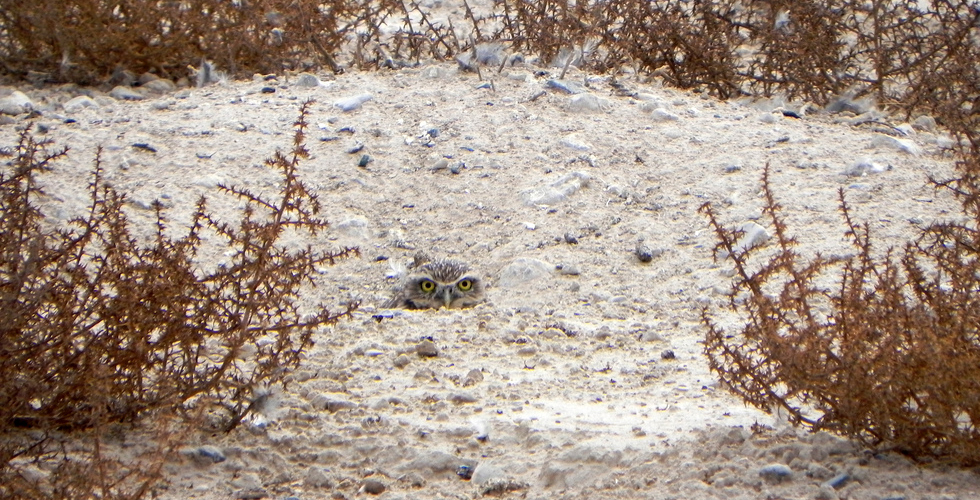Squatting Owls Eavesdrop On Prairie Dogs

USFWS Pacific Southwest Region via flickr | http://bit.ly/1m9991t
(ISNS) -- The term "keystone species" was made for prairie dogs. These charismatic critters build vast underground towns across the plains, creating housing for themselves and many other animals. One of the squatters is the Western burrowing owl, a tiny insectivore that makes its home on the outskirts of prairie dog colonies.
New research suggests that the owls don't just gain a free home from the prairie dogs, but they also eavesdrop on the prairie dogs' sophisticated alarm calls, which scientists have described as a rudimentary form of grammar. The owls, less than a foot high, sneak tips about lurking predators from their highly vocal housemates, according to a study in next month’s Ethology.
Burrowing owls tend to seek out active prairie dog colonies in Colorado, where the study was conducted.
“The hypothesis was that living near active colonies helps them because the grass is shorter, and the predators have other animals to eat. We wanted to see if they were also getting something out of it by listening in on the prairie dogs,” said Rebecca Bryan, a biologist at the University of Colorado Denver, and the study's lead author.
To obtain recordings of the prairie dog calls, scientists tied a toy snake to some fishing line, then hid in a blind and pulled the snake through the prairie dogs' town. In response, the prairie dogs made barking noises that seem to mean "snake" -- and attacked the snake.
“I now have a rubber snake with about six inches of tail missing,” remarked Bryan.
Then, Bryan and Michael Wunder, another biologist at the University of Colorado Denver, studied the burrowing owls' response to the recorded prairie dogs during nesting season. The snake call was chosen because it was easy to record - no waiting for a hawk to swoop in - and because snakes eat owl eggs.
The team played three sounds for the owls: prairie dogs barking at a snake, a low-flying airplane, and cows mooing. The owls showed the strongest response to the barks, squatting low, chattering, and bobbing their heads significantly more than at the other two noises.
The owls are smart to take heed: prairie dogs have the most sophisticated language yet decoded among non-humans. Recent studies have shown that they have nouns, adjectives, verbs, and adverbs, which they can use to indicate the size, shape, color, and speed of an intruder. The social rodents even have different calls for a tall human in a blue shirt and a short human in a grey shirt.
“In the past, people shied away from the word language, because we didn’t have enough information. But it’s really clear now that’s what it is,” said Con Slobodchikoff, an animal behaviorist at Northern Arizona University in Flagstaff, who studies prairie dog calls.
The distinctive calls are necessary considering the wide variety of predators with which the prairie dogs must contend. The best response to a hawk is ducking underground, but if alerted to the presence of a snake, prairie dogs must stand up quickly to check the scene. More research is needed before scientists know if owls can understand the language, or if they just identify alarm calls in general. But either way, they’re far from the only animals that listen into other species’ conversations.
"Mammals eavesdrop on birds, birds eavesdrop on mammals - there's a whole communication network out there, and everyone is tuned into everyone's alarm calls," said Kenneth Schmidt, a behavioral ecologist at Texas Tech University in Lubbock. "There's even a non-vocalizing lizard that eavesdrops on mocking birds."
No one is quite sure if animal eavesdropping is learned or instinctive, although burrowing owls live across the Americas and not always in close proximity to other animals. But prairie dogs have recognizable local dialects, akin to what Americans might recognize about people from the South or New England. Some species of the rodent can’t understand each other at all. This strongly suggests the language is cultural, and burrowing owls have learned to take advantage of their chatty neighbors’ social ties.
But can these communications be called language without anthropomorphizing the animal kingdom?
“We have for a long time underestimated the ability of animals. We thought they were running on programs of instinct, like little robots,” said Slobodchikoff. “But in reality, they’re far more advanced and far smarter than we give them credit for, and with that acknowledgement we need to give animals more respect than we have been."
Cat Ferguson is a science and technology journalist based in California's Bay Area.
